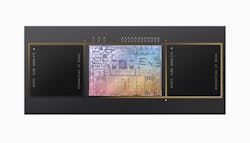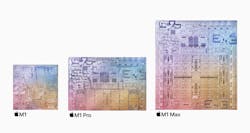Apple Pushes Out Intel With In-House M1 Pro Chip for High-End Laptops
Apple has become a semiconductor powerhouse over the last decade, expanding its chip design efforts from the in-house A-series processors for the iPhone and iPad to many of its other consumer gadgets.
But Apple is raising the bar with the M1 Pro and M1 Max chips at the heart of its new 14-inch and 16-inch MacBook Pro laptops, which the consumer electronics giant revealed at its virtual Unleashed event Monday.
The Cupertino, California-based company rolled out some laptops last year that, for the first time, used its in-house "Apple Silicon" chips. Apple announced plans to phase these chips into its desktop and laptop lineup over a two-year period, replacing the Intel chips used in Apple's personal computers for a decade and a half and giving it a firmer grip on the hardware and software inside its future Macs.
Apple placed the first generation of its internally-designed M1 processor in its mid-range 13-inch MacBook Pro and MacBook Air laptops as well as its 24-inch iMac and Mac Mini desktop in 2020. Apple also placed the M1 in its latest iPad Pro tablet. The M1 shocked the semiconductor industry with its combination of performance and power efficiency, which largely stems from the tight integration between Apple's silicon, hardware, and software.
But the company's premium laptops and desktops were still powered by Intel processors. But now Apple is replacing Intel's chips in all its laptops with the new M1 Pro processor and even more advanced M1 Max. (Figure 1).
Apple said it rearchitected the interconnect fabric in the M1 to scale it up to the level of the M1 Pro, which it said delivers "industry-leading" performance per watt along with more memory bandwidth and capacity. The chip—along with the M1 Max—is at the center of the most significant update to the MacBook Pro in years, which is targeted at photographers, software developers, and video editors that need more horsepower.
"Building a pro laptop has meant using a power-hungry CPU and discrete GPU," said Johny Srouji, SVP of hardware technologies at Apple, where he leads the consumer electronics maker's chip design department. "But a two-chip architecture requires more power and cooling," Srouji added. "It also means the CPU and GPU have separate pools of memory, so they have to copy data back and forth over a slower interface."
But the M1 Pro and M1 Max are SoC designs that integrate the CPU and GPU on the same die, allowing both of the processors to share the same pool of DRAM memory, boosting memory bandwidth. "No one has ever applied a system-on-a-chip design to a pro system—until today," Srouji said.
Based on TSMC's 5-nm node, Srouji said the M1 Pro packs 33.7 billion transistors, which means better performance for general-purpose compute, graphics, and media compared to the standard M1 chip, which has 16 billion transistors.
At the heart of the M1 Pro is an up to 10-core CPU, including eight large high-performance cores (up from four in the M1) and two compact high-efficiency cores (down from four in the M1). Apple said its macOS Monterey operating system assigns threads to the CPU cores to maximize performance, and advanced power management features intelligently allocate tasks between different cores for better speeds and battery life.
Apple said customers can select different configuration options for the M1 Pro. The chip comes with an eight-core CPU (six performance cores, two efficiency cores) or a 10-core CPU (eight performance cores, two efficiency cores). For graphics, the M1 Pro can be equipped with a 14-core GPU or a 16-core GPU.
Apple said M1 Pro is leaps and bounds ahead of Intel chips in terms of performance and power efficiency.
Apple said the M1 Pro chip is up to 70% faster than the M1, depending on the workload, and the CPU inside delivers up to 1.7 times more performance than Intel's eight-core Core i7-10870H when using comparable power levels. In addition, Apple said the 10-core CPU in the M1 Pro can match the performance of Intel's chip, which is based on Intel's latest 10-nm SuperFin technology while consuming up to 70% less power (Figure 2).
The 14-inch model supports 17 hours of battery life while playing video, while the 16-inch gets 21 hours–10 more than previous MacBooks. With fast charging, the laptops only need a 30-minute charge to refill the battery to 50%.
The M1 Pro is supplemented by 32 GB of unified memory shared by all the processor components. That is up from 8 GB or 16 GB in the M1. Apple mounts the M1 Pro and RAM chips together in a custom system-in-package (SiP) design.
Apple said the M1 Pro integrates an up to 16-core GPU, a significant upgrade over the up to eight-core GPU in M1-based Macs. Apple said the GPU in the M1 Pro delivers up to double the performance of the M1, and it also outpaces the integrated graphics in rival silicon. The M1 Pro is up to seven times faster than the integrated graphics on Intel's eight-core laptop chips.
Apple said it can also beat out the discrete GPUs in current high-end laptops. According to internal tests, the M1 Pro can supply roughly the same graphics performance as Nvidia's GeForce RTX 3050 GPU while using as much as 70% less power. Apple said the 16-core graphics processor, which combines 2,048 execution units (EUs), pumps out 5.2 trillion floating-point operations per second (FLOPS).
Apple said it doubled the memory bus for the M1 Pro compared to its M1, moving from a 128-bit LPDDR4X interface to the wider and faster 256-bit LPDDR5 interface, promising system bandwidth of up to 200 GB/s.
The 16-core neural engine inside the M1 Pro can deliver up to 11 trillion operations per second (or TOPS) for on-device machine learning, giving it roughly the same performance as the neural engine in the previous M1 chipset. Paired with Apple's custom image signal processor (ISP), the neural engine helps the camera on the new MacBook Pros take higher-quality video and capture more natural-looking details on a person's face.
Apple said the M1 Pro also integrates its in-house secure enclave that supports hardware verified secure boot to keep out hackers. It is bringing other security protections into the fold, including in-line encryption.
Inside the M1 Pro is a new and improved Apple-designed media engine that offloads video processing from main the CPU and accelerates it without burning through battery life. The media engine incorporates a video decode engine, a video encode engine, a single hardware accelerator for Apple's ProRes video codec as well as other acceleration engines for codecs such as H.264, HVEC, and RAW. The media processor supports the smooth playback of up to 4 streams of high-resolution 4K and 8K video while maximizing battery life.
Apple is also restoring three ports that it removed years ago: the HDMI port, SD card slot, and the MagSafe charging connector. The new models also contain three USB-C ports that support Thunderbolt 4 and USB 4.
Also removed from the new models is the Touch Bar, the long, ruler-shaped touchscreen located above the keyboard on Apple's previous MacBook Pros. Instead, a fingerprint sensor sits inside the power button.
"With this, we've taken another huge step forward in the Mac's transition to Apple Silicon," said John Ternus, VP of hardware engineering at Apple.
Check out Part 2 to learn more about Apple's M1 Max.
About the Author
James Morra
Senior Editor
James Morra is the senior editor for Electronic Design, covering the semiconductor industry and new technology trends, with a focus on power electronics and power management. He also reports on the business behind electrical engineering, including the electronics supply chain. He joined Electronic Design in 2015 and is based in Chicago, Illinois.



